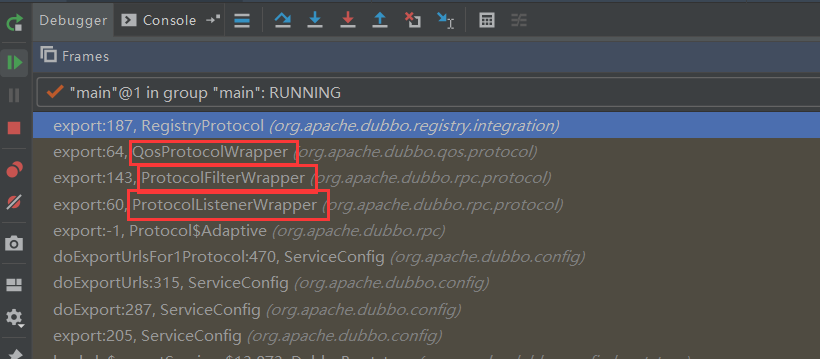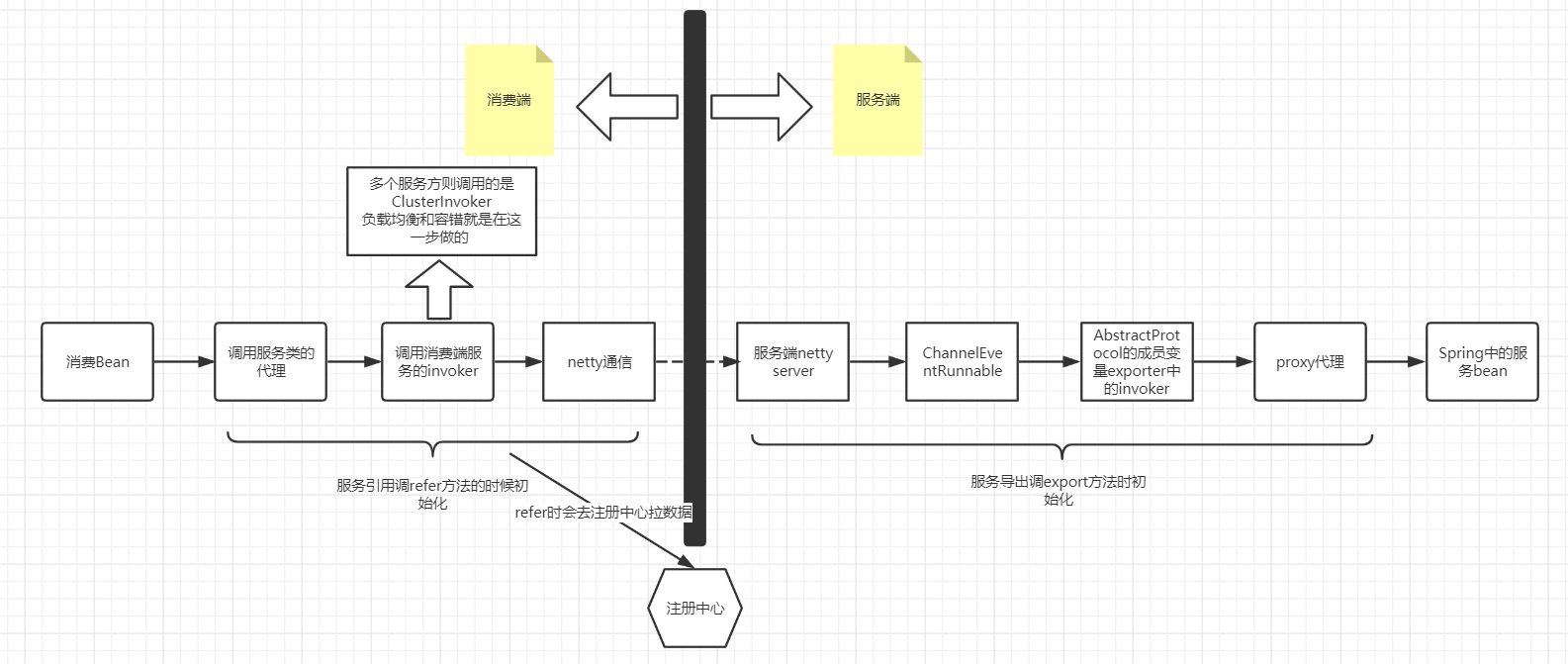前言
本周空闲时间利用了百分之六七十的样子。主要将Dubbo官网文档和本地代码debug结合起来学习,基本看完了服务导出、服务引入以及服务调用的过程,暂未涉及路由、字典等功能。下面对这一周的收获进行一下总结梳理。
一、基于事件驱动的服务导出
提起服务导出,不要被它的名字误导了,通俗点说就是服务的暴露和注册。服务的暴露是指将服务端的端口开放,等待消费端来连接。服务的注册即将服务信息注册到注册中心。针对服务暴露和注册的具体流程,可参见博主之前的一篇文章 https://www.cnblogs.com/zzq6032010/p/11275478.html ,讲述的比较详细,暂不赘述。
注重提一下的是Dubbo启动服务暴露和注册的时机,是采用的事件驱动来触发的,跟SpringBoot有点神似。这种通过事件驱动来触发特定逻辑的方式,在实际开发工作中也可以灵活使用。
二、服务引入及SPI
对于Dubbo的SPI自适应扩展,可参见博主之前的一篇文章 https://www.cnblogs.com/zzq6032010/p/11219611.html,但此篇文章当时写的比较浅显,还未悟得全部。
下面以Protocol类为例,看一下在ServiceConfig类中的成员变量 Protocol protocol = ExtensionLoader.getExtensionLoader(Protocol.class).getAdaptiveExtension() 是什么样子。
1 package org.apache.dubbo.rpc; 2 import org.apache.dubbo.common.extension.ExtensionLoader; 3 public class Protocol$Adaptive implements org.apache.dubbo.rpc.Protocol { 4 5 public void destroy() { 6 throw new UnsupportedOperationException("The method public abstract void org.apache.dubbo.rpc.Protocol.destroy() of interface org.apache.dubbo.rpc.Protocol is not adaptive method!"); 7 } 8 9 public int getDefaultPort() { 10 throw new UnsupportedOperationException("The method public abstract int org.apache.dubbo.rpc.Protocol.getDefaultPort() of interface org.apache.dubbo.rpc.Protocol is not adaptive method!"); 11 } 12 13 public org.apache.dubbo.rpc.Exporter export(org.apache.dubbo.rpc.Invoker arg0) throws org.apache.dubbo.rpc.RpcException { 14 if (arg0 == null) throw new IllegalArgumentException("org.apache.dubbo.rpc.Invoker argument == null"); 15 if (arg0.getUrl() == null) throw new IllegalArgumentException("org.apache.dubbo.rpc.Invoker argument getUrl() == null"); 16 org.apache.dubbo.common.URL url = arg0.getUrl(); 17 String extName = ( url.getProtocol() == null ? "dubbo" : url.getProtocol() ); 18 if(extName == null) throw new IllegalStateException("Failed to get extension (org.apache.dubbo.rpc.Protocol) name from url (" + url.toString() + ") use keys([protocol])"); 19 org.apache.dubbo.rpc.Protocol extension = (org.apache.dubbo.rpc.Protocol)ExtensionLoader.getExtensionLoader(org.apache.dubbo.rpc.Protocol.class).getExtension(extName); 20 return extension.export(arg0); 21 } 22 23 public org.apache.dubbo.rpc.Invoker refer(java.lang.Class arg0, org.apache.dubbo.common.URL arg1) throws org.apache.dubbo.rpc.RpcException { 24 if (arg1 == null) throw new IllegalArgumentException("url == null"); 25 org.apache.dubbo.common.URL url = arg1; 26 String extName = ( url.getProtocol() == null ? "dubbo" : url.getProtocol() ); 27 if(extName == null) throw new IllegalStateException("Failed to get extension (org.apache.dubbo.rpc.Protocol) name from url (" + url.toString() + ") use keys([protocol])"); 28 org.apache.dubbo.rpc.Protocol extension = (org.apache.dubbo.rpc.Protocol)ExtensionLoader.getExtensionLoader(org.apache.dubbo.rpc.Protocol.class).getExtension(extName); 29 return extension.refer(arg0, arg1); 30 } 31 32 public java.util.List getServers() { 33 throw new UnsupportedOperationException("The method public default java.util.List org.apache.dubbo.rpc.Protocol.getServers() of interface org.apache.dubbo.rpc.Protocol is not adaptive method!"); 34 } 35 }
这就是getAdaptiveExtension()之后得到的代理类,可见在初始化ServiceConfig时先获取的protocol只是一个代理Protocol类,程序运行时再通过传入的Url来判断具体使用哪个Protocol实现类。这才是SPI自适应扩展的精髓所在。
除此之外,在通过getExtension方法获取最终实现类时,还要经过wrapper类的包装。详见ExtensionLoader类中的如下方法:
1 private T createExtension(String name) { 2 Class<?> clazz = getExtensionClasses().get(name); 3 if (clazz == null) { 4 throw findException(name); 5 } 6 try { 7 T instance = (T) EXTENSION_INSTANCES.get(clazz); 8 if (instance == null) { 9 EXTENSION_INSTANCES.putIfAbsent(clazz, clazz.newInstance()); 10 instance = (T) EXTENSION_INSTANCES.get(clazz); 11 } 12 injectExtension(instance); 13 Set<Class<?>> wrapperClasses = cachedWrapperClasses; 14 if (CollectionUtils.isNotEmpty(wrapperClasses)) { 15 for (Class<?> wrapperClass : wrapperClasses) { 16 instance = injectExtension((T) wrapperClass.getConstructor(type).newInstance(instance)); 17 } 18 } 19 initExtension(instance); 20 return instance; 21 } catch (Throwable t) { 22 throw new IllegalStateException("Extension instance (name: " + name + ", class: " + 23 type + ") couldn't be instantiated: " + t.getMessage(), t); 24 } 25 }
如果接口存在包装类,则在第16行进行wrapper类的处理,将当前instance封装进包装类中,再返回包装类的实例,即通过这一行代码实现了扩展类的装饰器模式改造。
此处同样以Protocol类为例,Url中的协议是registry,那么我最终执行到RegistryProtocol的export方法时栈调用路径是这样的:

即中间经过了三层Wrapper的封装,每层都有自己特定的功能,且各层之间互不影响。Dubbo在很多自适应扩展接口处加了类似这样的装饰扩展,程序的可扩展设计还可以这样玩,Interesting!
服务引入的流程大体是这样的:消费端从注册中心获取服务端信息,封装成Invoker,再封装成代理类注入消费端Spring容器。流程比较简单,可自行根据上一节的内容debug调试。
三、服务调用的疑问
之前未看Dubbo源码时一直有一个疑问:dubbo的消费端代理类调用服务端接口进行消费时,是通过netty将消息发送过去的,服务端在接收到消息后,是如何调用的服务端目标类中的方法?反射吗?反射可以调用到方法,但是没法解决依赖的问题,而且正常情况服务端调用应该也是Spring容器中已经实例化好的的服务对象,那是如何通过netty的消息找到Spring中的对象的?
实际dubbo处理的很简单,只要在服务暴露的时候将暴露的服务自己存起来就好了,等消费端传过来消息的时候,直接去map里面取,取到的就是Spring中封装的那个服务对象,very easy。

服务调用过程草图
如上图所示,服务调用的流程大体是这样的:调用之后通过client远程连接到server,在server端维护了暴露服务的一个map,服务端接收到请求后去map获取Exporter,exporter中有服务端封装好的Invoker,持有Spring中的服务bean,最终完成调用。中间还涉及很多细节,比如netty的封装与调用,序列化反序列化,负载均衡和容错处理等。
小结
Dubbo作为一个优秀的rpc服务框架,其优势不止在于它的rpc过程,还在于更多细节模块的实现以及可扩展的设计,比如序列化处理、负载均衡、容错、netty的线程调度、路由、字典... 内容挺多的,后面打算针对dubbo的四大负载均衡算法做一下研究,浅尝辄止,不求甚解!